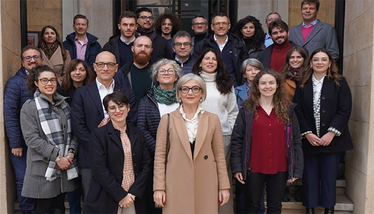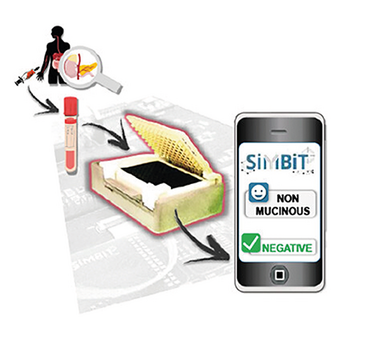The Single Molecule Sensor
Luisa Torsi introduces SiMoT – a unique ultrasensitive biosensor for point-of-care screening and biomedical research for COVID-19, cancer, and more…
Markella Loi | | 5 min read | Interview

We recently asked our 2023 Power List champions about the most important development in analytical science over the past decade. You are likely familiar with many of the areas highlighted (the Orbitrap, single-cell proteomics, and so on); but what about the “single-molecule--with-a-large-transistor” (SiMoT) platform? Well, according to Marcello Locatelli, SiMoT has been “fundamental for the field.”
Luisa Torsi, Professor of Analytical Chemistry at the University of Bari and President of the Regional Center on Single-Molecule Digital Assay, Italy, and her team introduced the SiMoT platform in 2018 to overcome challenges with existing molecular technologies such as next generation sequencing (NGS) and nanopores – especially their inability to detect single molecules in bulk samples. SiMoT incorporates electrolyte-gated organic-field-effect-transistors (EGOFETs) to achieve single-molecule detection of proteins and DNA.
More recently, Torsi and her team used SiMoT to improve detection of interleukin-6 (IL-6), a pleiotropic cytokine that is present in many pathologies, including cancer, cardiovascular, and metabolic diseases. The team successfully assessed levels of IL-6 using SiMoT in 30 minutes, reporting a limit of detection (LOD) of 1 ± 1 protein in a sample of 0.1 ml.
Following this promising research, we sought out SiMoT pioneer Luisa Torsi to find out more.
What inspired you to develop the single-molecule-with-a-large-transistor (SiMoT) platform?
I'm typically driven by curiosity, and I enjoy delving into issues that have not been extensively investigated before; I prefer to explore new avenues rather than perfecting topics initiated by other scientists. I also look into the potential applications so as to make sure what we study is of relevance for our everyday life. This approach is often very challenging and high risk, but can be potentially also high gain. In any case, it’s the way I prefer to work.
I was captivated by the idea of pushing electronic sensing to its ultimate limit, and I became convinced that this could be achieved, considering how sensitive these devices already were at the time when I started working on this topic. My intuition was somewhat correct, but it required a significant effort from an entire interdisciplinary team and several projects to actually prove it.

Could you describe the main features of your technology?
The SiMoT umbrella technology consists of two platforms: one designed for assaying a single marker/pathogen (for example, SARS-CoV-2), while the other is an array capable of simultaneously assaying multiple markers.
SiMoT devices, comprising a reusable reader and a smaller accessory disposable cartridge specific for early disease diagnosis, are ultra-portable and handheld. Importantly, they only require a smart device like a phone or tablet with a Wi-Fi connection to operate, allowing them to function in a fully equipment-free environment. The single-marker assay platform is user-friendly and cost-effective, suitable for use by untrained individuals – even in home – or in resource-limited settings typical of underdeveloped countries. In contrast, the array technology is better suited for trained personnel, both in clinical settings and decentralized facilities such as doctor’s offices or small, partially equipped clinical laboratories.
SiMoT can achieve single-molecule sensitivities (the limit of identification) with diagnostic sensitivity and selectivity exceeding 96 percent. This surpasses state-of-the-art technologies used for diagnosing conditions, such as pancreatic cancer, which typically achieve sensitivities in the range of 60-70 percent. SiMoT’s capability reduces the occurrence of false negatives, potentially saving lives worldwide, especially in less developed countries. The technology is also rapid, providing results in about 30–90 minutes for the single marker assay and an hour for the array.
The electronic reader and data collection enable straightforward remote control of the entire assay process. Full data connectivity facilitates integration with digital platforms and seamless connectivity to electronic health records, streamlining data management, analysis, and reporting.

What are the main potential applications of SiMoT?
SiMoT devices are uniquely well-suited for point-of-care testing (POCT) screening among asymptomatic individuals, allowing highly reliable, rapid, and cost-effective identification of those who are ill. They can address a large number of different diseases by simply changing the recognition element, such as the capturing antibody or the probe, integrated with the disposable accessory cartridge.
Our technology enables both proteins/antigens and nucleic acid strand markers to be assayed from the same biofluid with the same level of performance, opening a new perspective in cancer and progressive disease early diagnosis. We have also demonstrated its applicability for SARS-CoV-2 detection directly in saliva and for pancreatic cancer early diagnosis directly from a blood test.
What were the major challenges during development?
We had to confront several significant challenges, such as achieving very high reproducibility. We overcome these obstacles by meticulously delving into the understanding of the process and its mechanisms.
Moreover, through repeated experiments, we developed highly repeatable protocols that could be applied not only within the lab but also in portable devices outside the lab. SiMoT would not have been possible without the support and hard work of my colleagues, Dr. Eleonora Macchia, Prof. Fabrizio Torricelli.
Have you implemented any recent design changes to improve your platform?
Yes we have! We originally started constructing our bioelectronic device with a new technology based on organic semiconductors. We then realized that we could also use CMOS-based technology, which offered much better potential for scalability and production at low cost. Eventually, we settled for the latter to enhance our platform.
We would love to commercialize our technology soon. Thankfully, we are about to enter the clinical trial stage – involving 1000 assays to validate the device’s performance level.
What lessons have you learned along the way?
It has made me realize the significance of the analytical scientist’s job! Moreover, developing SiMoT technology has been critical for my career and has made me very committed to role-modeling and mentoring younger scientists – especially women.
In a recent campaign by the Bracco Foundation, I had the opportunity to be featured in a story of TOPOLINO – a cartoon comic series – as “Louise Torduck.” My character portrays a successful female scientist of the Calisota Valley and highlights how important and exciting science can be to the younger audiences – hoping to inspire them and show them that anything you want is possible.
So I would say, this research has taught me that you should always follow your dream and never give up!
Headshot - Credit: Marianna Ladisa Photography. Group photo - The SiMBiT project consortium (https://www.simbit-h2020.eu/). Figure - Credit: Supplied by Interviewee
Associate Editor, The Analytical Scientist

















